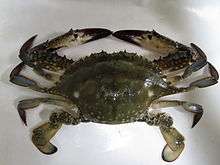Portunus trituberculatus
| Portunus trituberculatus | |
|---|---|
 | |
| Scientific classification | |
| Kingdom: | Animalia |
| Phylum: | Arthropoda |
| Subphylum: | Crustacea |
| Class: | Malacostraca |
| Order: | Decapoda |
| Infraorder: | Brachyura |
| Family: | Portunidae |
| Genus: | Portunus |
| Species: | P. trituberculatus |
| Binomial name | |
| Portunus trituberculatus (Miers, 1876) | |
| Synonyms [1] | |
|
Neptunus trituberculatus Miers, 1876 | |
Portunus trituberculatus, the gazami crab, Japanese blue crab or horse crab, is the most widely fished species of crab in the world. It is found off the coasts of East Asia and is closely related to Portunus pelagicus.
Fishery
P. trituberculatus is the world's most heavily fished crab species, with over 300,000 tonnes being caught annually, 98% of it off the coast of China.[2]
Distribution
P. trituberculatus is found off the coasts of Japan, Korea, China, Pakistan and Taiwan.[3]
Description
The carapace may reach 15 centimetres (5.9 in) wide, and 7 cm (2.8 in) from front to back. P. trituberculatus may be distinguished from the closely related (and also widely fished) P. pelagicus by the number of broad teeth on the front of the carapace (3 in P. trituberculatus, 4 in P. pelagicus) and on the inner margin of the merus (4 in P. trituberculatus, 3 in P. pelagicus).[2]
Taxonomy
P. trituberculatus was first described by Edward J. Miers in 1876, under the name Neptunus trituberculatus.[1]
References
- 1 2 Peter Davie (2010). "Portunus (Portunus) trituberculatus (Miers, 1876)". World Register of Marine Species. Retrieved May 6, 2011.
- 1 2 "FAO fisheries global information system". Retrieved August 2, 2006.
- ↑ "Portunus trituberculatus". Crabs of Japan. Marine Species Identification Portal. Retrieved March 20, 2011.